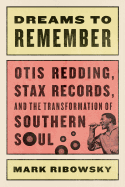
In the 1960s, when African American music accelerated its climb out of the vinyl pigeonhole known as "race music," it was primarily pulled up by two very different recording studios. In the northern big city of Detroit, Berry Gordy, Jr., created Motown and promoted his artists' carefully produced style with an iron fist and relentless focus on publicity and profits. In the smaller, southern river city of Memphis, Jim Stewart and his sister, Estelle Axton, bootstrapped the Stax Studio out of a neighborhood record store with the local house band Booker T. and the MGs.
With acts like Smokey Robinson, Marvin Gaye and the Supremes, Motown was the clear powerhouse--until 20-year-old Otis Redding blew away Stax guitarist and producer Steve Cropper, belting out two songs he had written himself. As Mark Ribowsky describes that night in Dreams to Remember, Redding didn't have any arrangements for the band and had only one directive: "Just gimme those church things." His voice did the rest, and Memphis soul music was born, with Stax studios as its "Soulsville" home.
Redding's career was at its peak just six months before the plane crash that took his life, when he closed the second night of the 1967 Monterrey Pop Festival. Standing out among the Summer of Love line-up that included Janis Joplin and the Who, Redding stole the show with his rousing finale of "Try a Little Tenderness." Ribowsky's meticulous biography makes it clear that Arthur Conley's 1967 hit "Sweet Soul Music" (co-written by Redding) got it wrong. James Brown wasn't "the king of them all, y'all." Otis was. --Bruce Jacobs, founding partner, Watermark Books & Cafe, Wichita, Kan.

